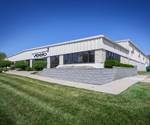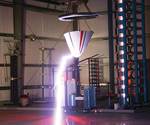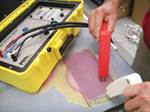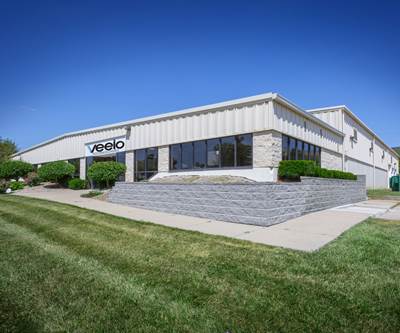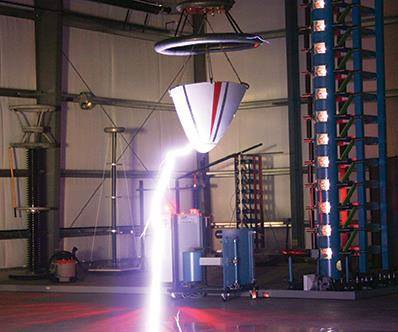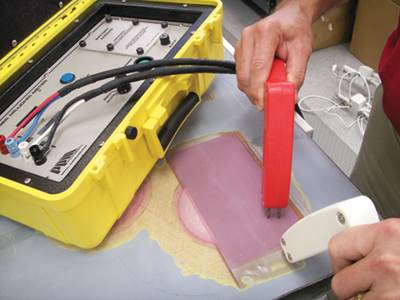Ducommun licenses WSU lightning strike protection for composite wind blades
New technology showed no damage after up to 8 lightning strikes and can be repaired in 20 minutes.
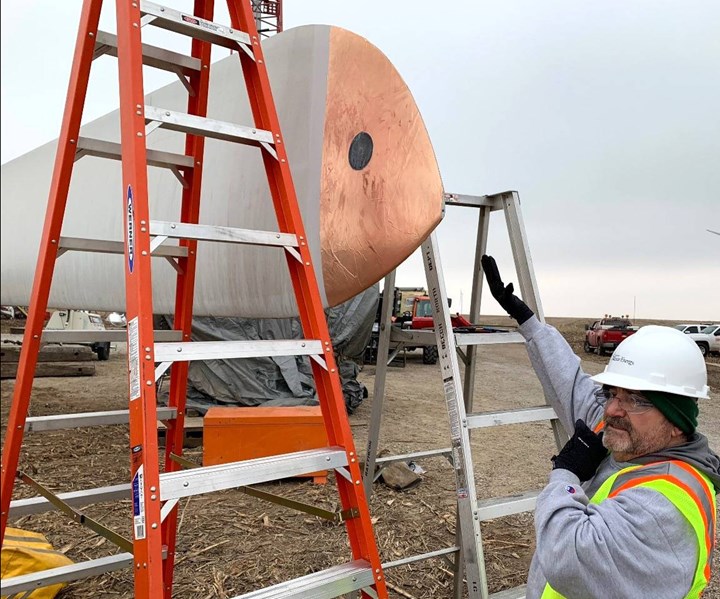
Billy Martin works on a composite wind turbine blade to test technology he has invented for protecting blades from lightning strikes. Martin is director and senior research scientist in the Environmental Test Lab at WSU's National Institute for Aviation Research (NIAR). SOURCE | WSU NIAR.
Ducommun Incorporated (Santa Ana, Calif., U.S.) has announced that its (LDS) brand, a global leader in the design and manufacture of segmented lightning diverter strips and protection devices for aerospace and defense markets, has signed an exclusive licensing agreement with (WSU, Wichita, Kan., U.S.) for advanced lightning strike protection technology to be used on composite blades for wind turbines.
Ducommun officials said LDS will further develop and commercialize the technology, originally developed at WSU’s National Institute for Aviation Research (NIAR), and offer it to targeted wind turbine original equipment manufacturers (OEMs) and operators in the U.S. and select international markets who want more robust, cost-efficient lightning strike protection.
Dave Wilmot, vice president and general manager of the Engineered Products Group for Ducommun Incorporated, said LDS currently supports approximately 3,000 wind turbine blades worldwide with its segmented diverter strips, which has provided direct insight on the unmet need for more robust protection.
Expensive problem, layered solution
“There are currently more than 341,000 wind turbines operating worldwide, with more than 56,000 of those based in North America,” says Wilmot. “All of them are susceptible to lightning strikes, which can cause significant and costly damage to wind turbine components such as blades, controls and electrical systems.” Average costs to repair or replace a gearbox component or a damaged turbine blade can be as high as $380,000 and $240,000, respectively. “While wind turbine blades have existing lightning protection systems,” Wilmot continues, “these systems are unable to effectively transfer lightning current to the ground. By partnering with Wichita State University on this innovative technology, our goal is to develop advanced protection for wind turbines, which means they stay in the field longer, they stay on the turbines longer, and there is less material going into landfills or recycling.”
The technology enhances the lightning protection system of existing blades, ensuring that the lightning current is properly transferred to the grounding connection. This minimizes (and in some cases eliminates) the damage done to underlying blade surfaces and sensitive electrical components. This technology was developed by Billy Martin, director and senior research scientist in the Environmental Test Lab at WSU NIAR. With help from WSU Ventures, Martin partnered with LDS to refine the technology for commercialization.
According to a 2017 WSU article, prior devices had issues with reliability, were generally single-use and required significant turbine downtime when repair was required. Martin's design involves layers that allow turbine blades to withstand multiple lightning strikes without sustaining damage. A recent test showed no damage after up to eight lightning strikes. When damage does occur to the protective layering, it can be repaired in approximately 20 minutes, not counting the time it takes to reach a blade that is already installed. The protective layering can be applied to turbine blades prior to installation.
Lightning protection capabilities for wind and aerospace
“[This agreement] offers us an opportunity to partner with a highly respected university and research institute on the latest technologies and advancements, while applying our existing expertise in lightning protection capabilities and solutions for aerospace and defense to support this targeted use in the wind energy sector,” said Ducommun chairman, president and CEO Stpehen G. Oswald.
“The type of technology we’re developing with NIAR and Lightning Diversion Systems shows WSU’s dedication to leverage our expertise and research strengths to diversify the economy,” said Jay Golden, WSU president.
“Developing technology in the wind energy industry is a point of emphasis,” said Rob Gerlach, WSU director of technology transfer. “Given our aviation expertise, we have the ability to innovate in unique ways that can disrupt the industry.”
NIAR's Environmental Test Lab conducts testing to assess the direct effects of lighting, aircraft lighting transient analysis and lightning induced transient susceptibility.
About Ducommun Incorporated
Ducommun Incorporated delivers value-added, innovative manufacturing solutions to customers in the aerospace, defense and industrial markets. Founded in 1849, the company specializes in two core areas –Electronic Systems and Structural Systems – to produce complex products and components for commercial aircraft platforms, mission-critical military and space programs, and sophisticated industrial applications. In 2017, Ducommun Incorporated acquired Lightning Diversion Systems (LDS), a global leader in the design, development and production of segmented lightning diverter strips, devices and products for the military, aerospace and wind energy sectors.
Related Content
Otto Aviation launches Phantom 3500 business jet with all-composite airframe from Leonardo
Promising 60% less fuel burn and 90% less emissions using SAF, the super-laminar flow design with windowless fuselage will be built using RTM in Florida facility with certification slated for 2030.
Read MoreThe next-generation single-aisle: Implications for the composites industry
While the world continues to wait for new single-aisle program announcements from Airbus and Boeing, it’s clear composites will play a role in their fabrication. But in what ways, and what capacity?
Read MoreWelding is not bonding
Discussion of the issues in our understanding of thermoplastic composite welded structures and certification of the latest materials and welding technologies for future airframes.
Read MoreCombining multifunctional thermoplastic composites, additive manufacturing for next-gen airframe structures
The DOMMINIO project combines AFP with 3D printed gyroid cores, embedded SHM sensors and smart materials for induction-driven disassembly of parts at end of life.
Read MoreRead Next
Plant Tour: Veelo Technologies, Woodlawn, Ohio, U.S.
Advanced materials company evolves from nanomaterials to multifunctional composites and processing solutions.
Read MoreLightning strike protection strategies for composite aircraft
Tried-and-true materials thrive, but new approaches and new forms designed to process faster are entering the marketplace.
Read MoreAfter lightning strikes: Repair considerations
When lightning does strike, aircraft LSP system repairs must be done correctly to ensure restoration of protection.
Read More
